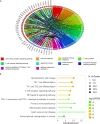Key pathways and genes that are altered during treatment with hyperbaric oxygen in patients with sepsis due to necrotizing soft tissue infection (HBOmic study)
- PMID: 37946314
- PMCID: PMC10636866
- DOI: 10.1186/s40001-023-01466-z
Key pathways and genes that are altered during treatment with hyperbaric oxygen in patients with sepsis due to necrotizing soft tissue infection (HBOmic study)
Abstract
Background: For decades, the basic treatment strategies of necrotizing soft tissue infections (NSTI) have remained unchanged, primarily relying on aggressive surgical removal of infected tissue, broad-spectrum antibiotics, and supportive intensive care. One treatment strategy that has been proposed as an adjunctive measure to improve patient outcomes is hyperbaric oxygen (HBO2) treatment. HBO2 treatment has been linked to several immune modulatory effects; however, investigating these effects is complicated due to the disease's acute life-threatening nature, metabolic and cell homeostasis dependent variability in treatment effects, and heterogeneity with respect to both patient characteristics and involved pathogens. To embrace this complexity, we aimed to explore the underlying biological mechanisms of HBO2 treatment in patients with NSTI on the gene expression level.
Methods: We conducted an observational cohort study on prospective collected data, including 85 patients admitted to the intensive care unit (ICU) for NSTI. All patients were treated with one or two HBO2 treatments and had one blood sample taken before and after the intervention. Total RNAs from blood samples were extracted and mRNA purified with rRNA depletion, followed by whole-transcriptome RNA sequencing with a targeted sequencing depth of 20 million reads. A model for differentially expressed genes (DEGs) was fitted, and the functional aspects of the obtained set of genes was predicted with GO (Gene Ontology) and KEGG (Kyoto Encyclopedia of genes and Genomes) enrichment analyses. All analyses were corrected for multiple testing with FDR.
Results: After sequential steps of quality control, a final of 160 biological replicates were included in the present study. We found 394 protein coding genes that were significantly DEGs between the two conditions with FDR < 0.01, of which 205 were upregulated and 189 were downregulated. The enrichment analysis of these DEGs revealed 20 GO terms in biological processes and 12 KEGG pathways that were significantly overrepresented in the upregulated DEGs, of which the term; "adaptive immune response" (GO:0002250) (FDR = 9.88E-13) and "T cell receptor signaling pathway" (hsa04660) (FDR = 1.20E-07) were the most significant. Among the downregulated DEGs two biological processes were significantly enriched, of which the GO term "apoptotic process" (GO:0006915) was the most significant (FDR = 0.001), followed by "Positive regulation of T helper 1 cell cytokine production" (GO:2000556), and "NF-kappa B signaling pathway" (hsa04064) was the only KEGG pathway that was significantly overrepresented (FDR = 0.001).
Conclusions: When one or two sessions of HBO2 treatment were administered to patients with a dysregulated immune response and systemic inflammation due to NSTI, the important genes that were regulated during the intervention were involved in activation of T helper cells and downregulation of the disease-induced highly inflammatory pathway NF-κB, which was associated with a decrease in the mRNA level of pro-inflammatory factors.
Trial registration: Biological material was collected during the INFECT study, registered at ClinicalTrials.gov (NCT01790698).
Keywords: Differential gene expression; Hyperbaric oxygen treatment; Immune cells; Inflammation; Necrotizing soft tissue infection; Sepsis; Systems medicine; Transcriptomics.
© 2023. The Author(s).
Conflict of interest statement
The authors declare that they have no competing interests.
Figures



Similar articles
-
Blood from septic patients with necrotising soft tissue infection treated with hyperbaric oxygen reveal different gene expression patterns compared to standard treatment.BMC Med Genomics. 2025 Jan 14;18(1):12. doi: 10.1186/s12920-024-02075-3. BMC Med Genomics. 2025. PMID: 39810178 Free PMC article.
-
Investigating the Effects of Hyperbaric Oxygen Treatment in Necrotizing Soft Tissue Infection With Transcriptomics and Machine Learning (the HBOmic Study): Protocol for a Prospective Cohort Study With Data Validation.JMIR Res Protoc. 2022 Nov 25;11(11):e39252. doi: 10.2196/39252. JMIR Res Protoc. 2022. PMID: 36427229 Free PMC article.
-
Hyperbaric oxygen treatment is associated with a decrease in cytokine levels in patients with necrotizing soft-tissue infection.Physiol Rep. 2021 Mar;9(6):e14757. doi: 10.14814/phy2.14757. Physiol Rep. 2021. PMID: 33719215 Free PMC article. Clinical Trial.
-
The Mechanisms of Action of Hyperbaric Oxygen in Restoring Host Homeostasis during Sepsis.Biomolecules. 2023 Aug 7;13(8):1228. doi: 10.3390/biom13081228. Biomolecules. 2023. PMID: 37627293 Free PMC article. Review.
-
[Hyperbaric oxygen therapy for necrotizing soft tissue infections: contra].Chirurg. 2012 Nov;83(11):960-72. doi: 10.1007/s00104-012-2284-z. Chirurg. 2012. PMID: 23138865 Review. German.
Cited by
-
Bayesian Modeling of the Impact of HBOT on the Reduction in Cytokine Storms.J Clin Med. 2025 Feb 11;14(4):1180. doi: 10.3390/jcm14041180. J Clin Med. 2025. PMID: 40004710 Free PMC article.
-
Blood from septic patients with necrotising soft tissue infection treated with hyperbaric oxygen reveal different gene expression patterns compared to standard treatment.BMC Med Genomics. 2025 Jan 14;18(1):12. doi: 10.1186/s12920-024-02075-3. BMC Med Genomics. 2025. PMID: 39810178 Free PMC article.
-
Use of Hyperbaric Oxygen in Patients with Necrotizing Soft Tissue Infections: A Scandinavian Multicenter, Prospective, Observational Cohort.Infect Dis Ther. 2025 Aug;14(8):1715-1738. doi: 10.1007/s40121-025-01184-5. Epub 2025 Jul 4. Infect Dis Ther. 2025. PMID: 40613866 Free PMC article.
References
-
- Madsen MB, Skrede S, Perner A, Arnell P, Nekludov M, Bruun T, et al. Patient's characteristics and outcomes in necrotising soft-tissue infections: results from a Scandinavian, multicentre, prospective cohort study. Intensive Care Med. 2019;45:1241–1251. doi: 10.1007/s00134-019-05730-x. - DOI - PubMed
Publication types
MeSH terms
Substances
Associated data
Grants and funding
LinkOut - more resources
Full Text Sources
Medical

